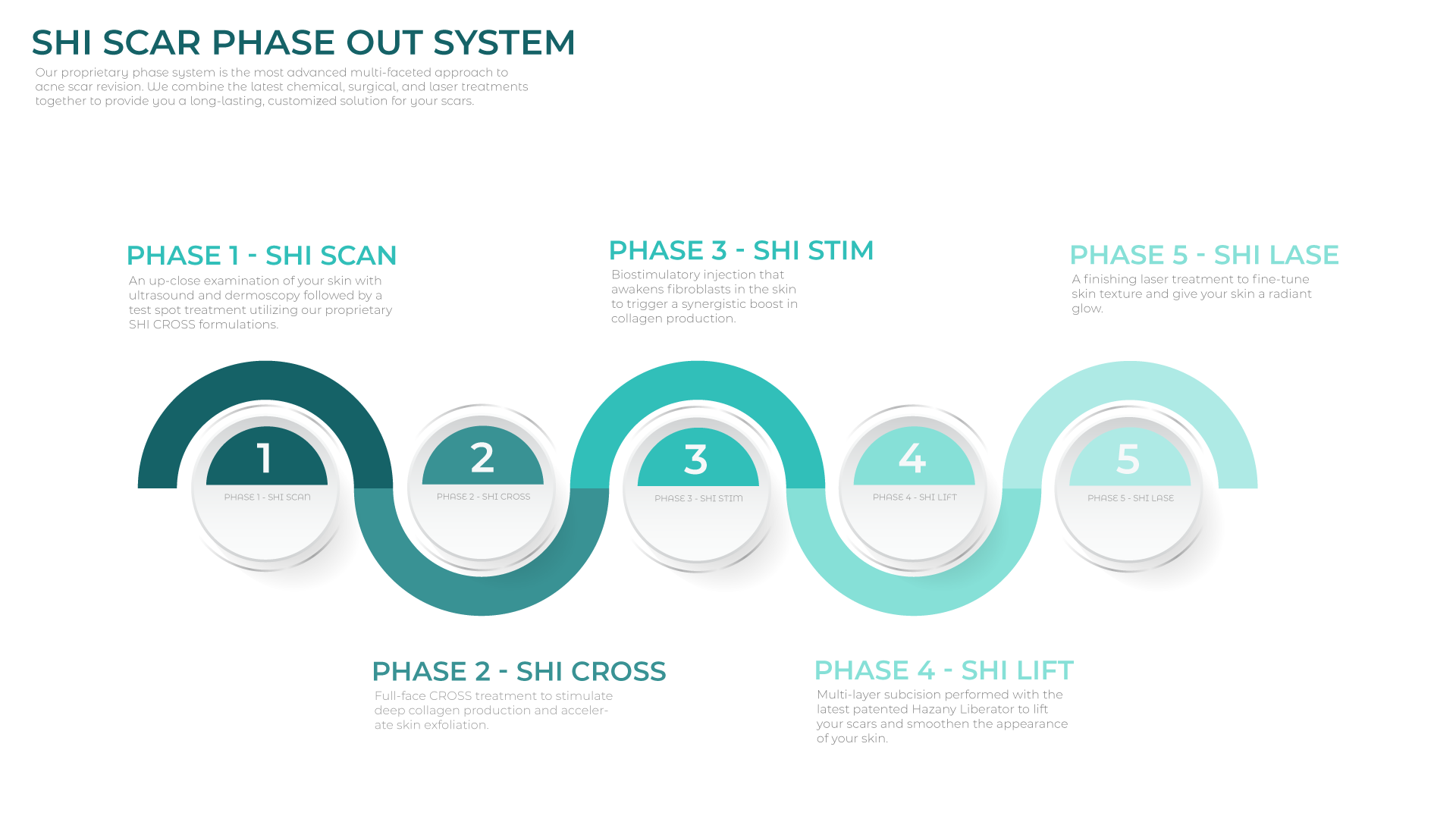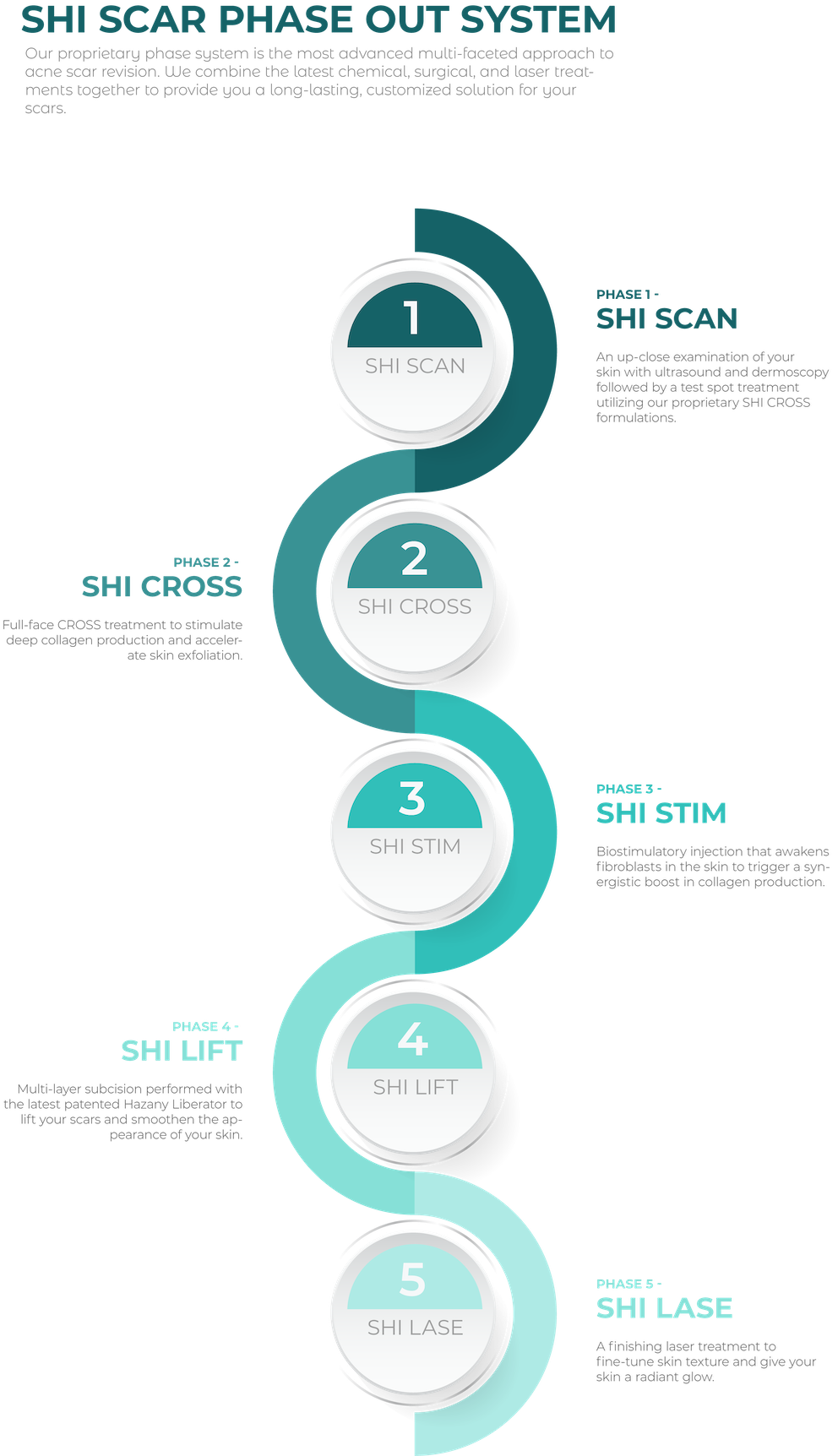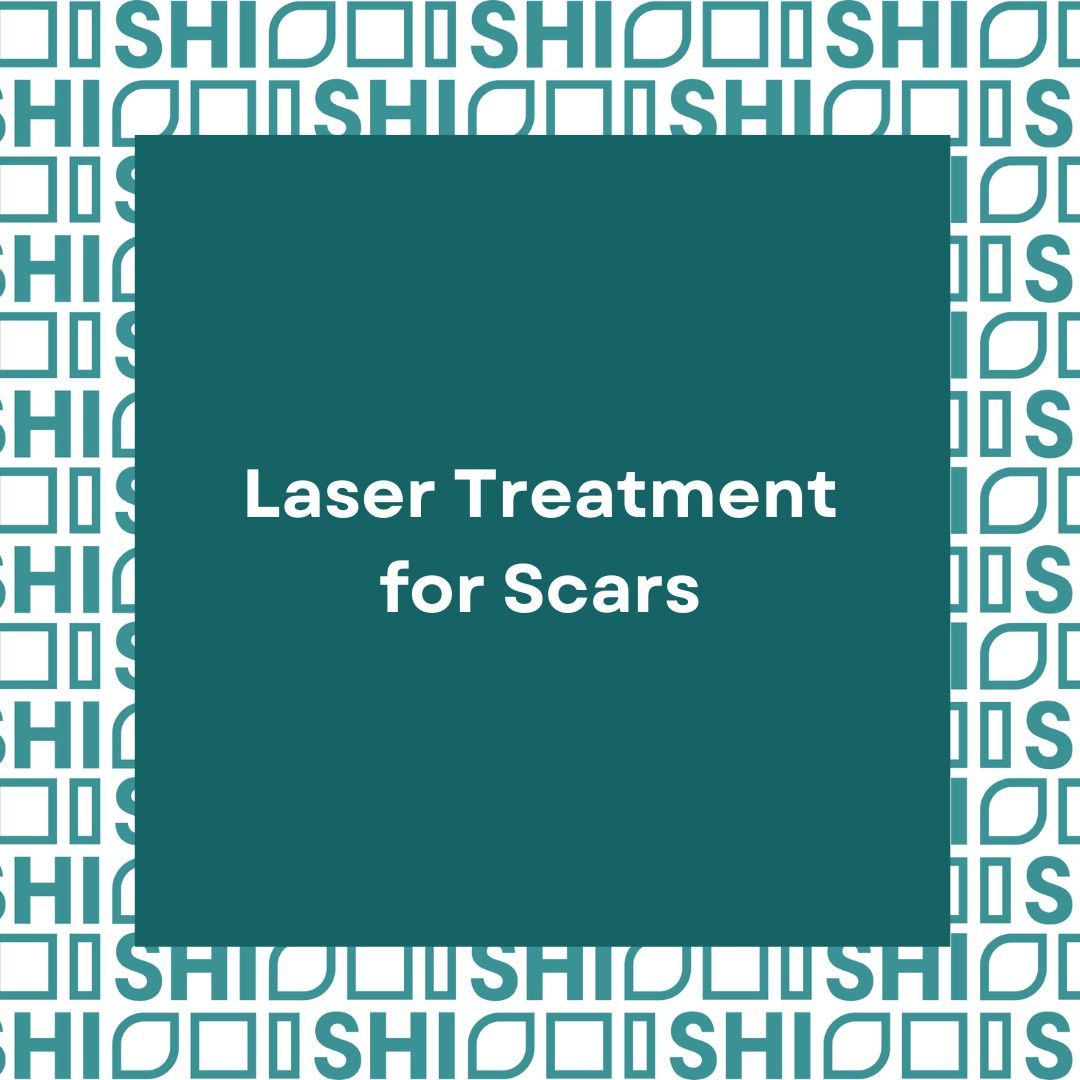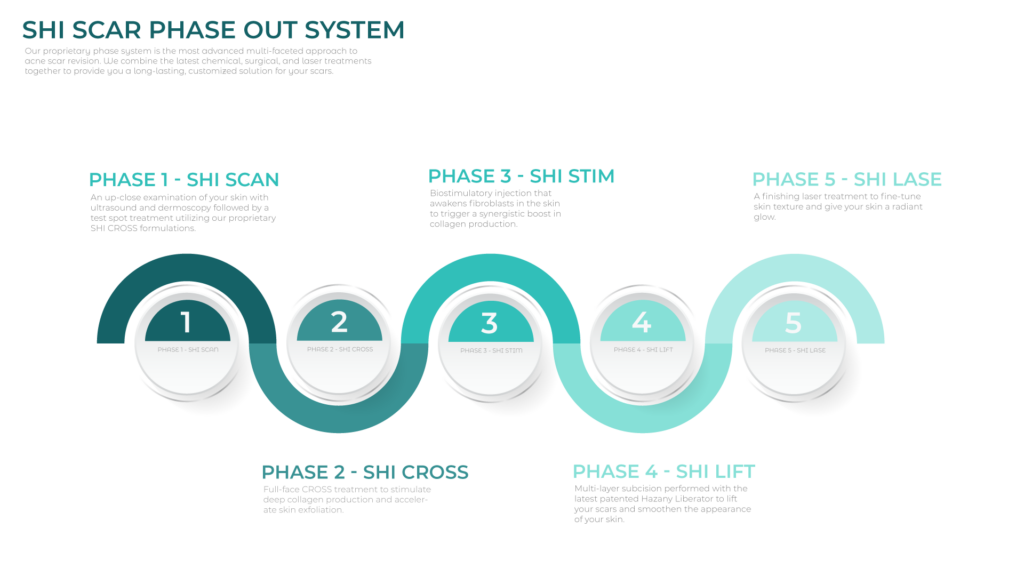If you’re contemplating scar removal by laser, you probably wonder if it’s right for you. This guide cuts straight to the chase: laser treatments can effectively minimize scars by targeting scar tissue with precision light energy. There are several options depending on your specific scar type. Below, you’ll find insights into how the treatments work, what to expect during recovery, and the risks involved – everything you need to make an informed decision.
Icepick Scars
Boxcar Scars
Rolling Scars
Key Takeaways on Laser Scar Removal
Understanding Laser Scar Removal
Laser scar removal, a process that harnesses light energy, significantly improves the appearance of scar tissue. The treatment offers a three-pronged approach: flattening and softening scars, blending pigmentation with surrounding healthy tissue, and stimulating collagen production to improve the overall appearance. The treatment uses photothermal energy to specifically target molecular structures within scar tissue, initiating the reorganization of dermal collagen and elastin. It may also involve laser skin resurfacing to rejuvenate the skin’s surface.
Laser treatment has proven effective in improving a range of scar types, including keloids, hypertrophic scars, and atrophic scars like those caused by acne, making it a popular choice for scar management.
Types of Skin Scars Treated with SHI Lase
CROSS is specifically designed to treat atrophic scars, which include various types of scars such as boxcar acne scars, ice-pick acne scars, and rolling acne scars:
Icepick Scars
Ice pick scars are characterized as narrow indentations in the skin that usually result from severe cystic or papular acne burrowing deep in the skin. Among the three, ice pick scars are the most severe due to their tiny diameter and depth of penetration. They often appear on the forehead, cheekbones, and nose.
Among the three, ice pick scars are the most difficult acne scar treatment because of their narrowness and depth of penetration. In general, we have found that ice pick scars respond well to phenol CROSS, our frontline treatment method. However, patients with more severe ice pick scars may benefit more from punch excision, a process in which a small “cookie-cutter” tool is used to punch out the ice pick scar. In this manner, we ensure that the scar is removed in its entirety, as opposed to other treatments that merely treat the surface.
Boxcar Scars
Boxcar scars have sharp defined boundaries with more geometric indentations in the skin.Boxcar scars result from collagen depletion caused by acne breakouts, leaving a visible depression behind on the skin. Boxcars are typically shallower and wider than ice pick scars, and have vertical walls with an even, flat base.
Although boxcar scars can be treated with a variety of procedures, many of them, including laser, dermabrasion, and microneedling, work superficially and are ineffective for deeper scars.At our clinic, subcision, punch excision, and collagen stimulators are the most effective and long-lasting treatment options available. We will perform a thorough evaluation of each of your boxcar scars to customize your treatment plan.
Rolling Scars
Rolling scars develop when fibrous tissue tethers the epidermis to the underlying subcutaneous tissue, creating sloping and wave-like indentations in the skin. Rolling scars are shallow and soft depressions that become more noticeable when skin ages and loses its elasticity. Rolling scars can disappear over time but may require intervention depending on their severity.
Because rolling scars are the softest among the different scar types, they respond the best to subcision followed by collagen stimulation. We will perform a thorough evaluation of your rolling scars to assess their severity and depth to determine what layers will need to be subcised. It is important to manually sever the fibrotic tethers in multiple layers to completely remodel the skin. Any treatments that do not target these tethers will not solve the root cause of rolling scars.
The precision and effectiveness of CROSS make it an attractive option for individuals seeking to diminish these types of acne scars and regain smooth, clear skin.
How Laser Treatments Work
Laser scar treatment operates with precision to treat scars. Beams of light are used to either remove scar tissue or stimulate the production of collagen, creating holes in the scar tissue and allowing the body to regenerate new, smoother skin. Collagen, the building block of our healthy skin, plays a vital role in skin healing by facilitating essential processes such as regulating inflammation, promoting new tissue growth, and contributing significantly to wound healing.
The body’s response to laser treatments is a gradual process, often taking several months, during which new, healthy skin develops, leading to a reduction in the visibility of scars over time. Laser technology is also precise in targeting scar tissue, directing photothermal energy towards intra- and extra-cellular structures within the scar tissue, while minimizing impact on the surrounding skin.
However, not all lasers are identical. Now, we will examine the different types used for scar removal.
Types of Lasers for Scar Removal
In the world of laser scar removal, different types of lasers serve different purposes because they differ in their wavelength. Some of the commonly used ones include:
- Fractional ablative lasers, which offer improved results with reduced recovery time compared to conventional fully ablative lasers.
- Fully ablative lasers
- Q-switched lasers, such as the Fotona Starwalker
Erbium:YAG lasers have gained recognition for their skin-resurfacing capabilities, which foster speedy healing without resulting in additional scarring. They also rejuvenate scarred tissue and stimulate the body’s production of new collagen, thereby contributing to the reduction of different types of scarring. Each type of laser has its unique advantages and is suited to different types of scars. Let’s take a closer look.
Erbium YAG Lasers (2940 nm)
Erbium YAG lasers operate by targeting the water content in skin cells, leading to their vaporization and the removal of micro-layers of skin. This process creates channels that encourage the production of new cells and collagen. Their efficacy in eliminating different skin lesions while causing minimal thermal damage to the treated skin makes them a safer option for addressing acne scars.
Potential side effects may include fibrosis, hypertrophic scarring, infection, transient erythema, edema, burning sensation, and pruritus.
CO2 Lasers (10600 nm, 2940 nm)
CO2 lasers are predominantly utilized for the treatment of fine lines, wrinkles, and various pigmentary disorders. They function by causing thermal damage below the area of scarring, proving to be effective in scar removal. They have demonstrated effectiveness in facilitating re-pigmentation and addressing conditions like vitiligo and melasma by specifically targeting the affected areas.
Fractional CO2 laser therapy plays a significant role in the healing process by normalizing collagen arrangement and stimulating the synthesis of new collagen fibers, thereby expediting the post-treatment healing response.
Q-switched lasers
Apart from Erbium:YAG and CO2 lasers, other types of lasers, such as Q-switched lasers, are also used for scar removal. These lasers work by storing energy and releasing the beam all at once, eliminating the outer skin layer at a much higher energy and generating heat in the underlying tissue. This triggers collagen production, resulting in enhanced skin tone and texture.
Q-switched lasers are especially effective in addressing atrophic facial acne scars, including atrophic scars, rolling scars, and larger boxcar scars.
Other Lasers (Non-Ablative Nd:YAG and KTP Lasers)
Non-ablative lasers, such as the Nd:YAG laser and the KTP laser, represent an advanced approach in the treatment of various types of scars, including acne scars, hypertrophic scars, and keloid scars. Unlike ablative lasers that remove the top layer of the skin, non-ablative lasers work by heating the underlying skin tissue without harming the surface, stimulating collagen production and promoting the natural healing process. This process helps in improving the texture and appearance of scars by making them less visible and more blended with the surrounding skin. The Nd:YAG laser is particularly beneficial due to its deeper penetration, which can be more effective for certain types of scars, while the KTP laser is known for its precision and ability to target superficial vascular changes, making it suitable for scars with a vascular component. Overall, non-ablative laser therapy offers a less invasive option with minimal downtime, making it an appealing choice for patients seeking to improve the appearance of their scars.
Our Impact on Scar Treatments
At the Scar Healing Institute, we use the most advanced laser technologies for our SHILase laser scar treatment. These include both ablative and non-ablative lasers. Our favorite ablative lasers for acne scars include Erbium laser (Er:YAG), Carbon dioxide (CO2), and the Q-switched Fotona Starwalker lasers. These powerful lasers are used skillfully by our expert acne scar treatment providers in both fractional and fully ablative modes to destroy unwanted scars and allow the skin to heal beautifully. At SHI, we also utilize non-ablative lasers including (Nd:YAG) and KTP to remodel scars and reduce redness that can contribute to their unsightly appearance. All of the lasers we use have a specific wavelength and frequency of light which allows them to penetrate to the exact depth into the skin to target the scars wherever they reside.
Preparing for Laser Scar Treatments
Before initiating your quest towards smoother skin, several key steps should be taken in preparation for laser scar treatment. The first step involves arranging a meeting with a skilled surgeon to address your individual requirements and examine your medical history associated with treating scars, such as its age, prior treatments, and the type of trauma or surgery that led to it.
Prior to the treatment, the following steps should be taken:
- Secure informed consent from the patient.
- Administer a topical anesthetic to the scar.
- Cleanse the treatment area using an antiseptic solution in preparation for the laser procedure.
Additionally, the pigmentation, pliability, and height of the scar should be thoroughly documented as part of the clinical assessment to aid in devising an effective treatment plan, including appropriate scar treatments.
Medical History and Consultation
Securing a medical consultation is vital as it enables a thorough assessment of your overall health, comorbidities, skin type, and scar characteristics. This ensures that the treatment is tailored effectively to your needs and can have a significant impact on the effectiveness of the scar removal.
The initial consultation for laser scar removal is expected to last approximately 30-45 minutes. Photographs are utilized during the treatment process to track the progress of scar removal and verify the attainment of desired outcomes.
Pre-Treatment Care
Prior to undergoing laser scar treatment, it’s advisable to:
- Abstain from photosensitive medications and over-the-counter pain relievers such as aspirin.
- Pre-treat with a hydroquinone to prevent hyperpigmentation.
- Refrain from exfoliating and temporarily discontinue the use of retinoid creams, glycolic acid, salicylic acid, or lactic acid treatments.
- Avoid sun exposure before and after laser scar removal treatment due to its potential to induce pigment changes in the skin, which could complicate the procedure and its results.
Moreover, abstain from smoking prior to a laser scar removal procedure as smoking can hinder the skin’s healing ability and disrupt blood flow, potentially impacting the procedure’s outcome negatively.
Laser Treatment Options for Different Scar Types
Given the variety of scars and laser treatments, comprehending the best laser treatment options for each scar type is necessary. This section will provide a detailed look at the different scar types and the best laser treatment options for each.
Whether it’s acne scars, hypertrophic scars, keloid scars, or surgical scars, laser treatment options vary, and it’s crucial to find the one that suits your specific needs.
Acne Scars
Although visible improvement can be seen with Er:YAG, CO2 and other fractional ablative laser treatment, lasers essentially use light to blend healthy skin around acne scars to match the level of the pitted scars. This allows a more even appearance. As a result, our firm belief at SHI is to avoid laser treatments as a first line treatment for acne scars. Instead, we believe that laser treatments are best used as a final “touch” treatment that smooths out your skin after your scar revision and healing during the Phase System. This way, laser treatments can be used as an effective refining and enhancing treatment to fine tune your skin’s appearance to your desired goals.
We often use non-ablative lasers and ablative lasers for acne scar removal. The best results can be achieved through a combination of skin-rejuvenating procedures, including:
- Non-ablative lasers
- Ablative lasers
- Chemical peels
- Microdermabrasion
- Microneedling
Non-ablative lasers are characterized by being less invasive with a shorter recovery time, whereas ablative lasers are known for being more invasive and necessitating a longer recovery period. Following laser treatment for acne scars, patients can anticipate the alleviation of any discomfort within one to two hours, with the redness possibly taking up to 10 days to diminish.
Hysterectomy Scars
Laser therapy, such as erbium:YAG laser therapy and CO2 laser therapy, can effectively minimize the visibility of hysterectomy scars by specifically targeting pigments and collagen layers in the skin. Additionally, it can eliminate undesired blood vessels and diminish the pink or inflamed aspect of the scars. Typically, patients will undergo approximately 4 – 6 laser scar treatment sessions to attain their desired outcome.
The 1550-nm NAFL outperformed the 595-nm PDL for the treatment of surgical scars, with 83% of patients expressing a preference for the half of the scar treated with a non-ablative fractional laser.
Breast Lift Scars
Nd:YAG redness lasers and erbium:YAG fractional resurfacing lasers have demonstrated effectiveness in addressing hypertrophic breast lift scars, with certain individuals experiencing reductions in scar erythema and flattening of up to 57% following a single treatment, and up to 83% after subsequent sessions. Nd:YAG laser treatment operates through the selective photolysis of scar tissue to disrupt microvessels, thereby contributing to the reduction of red or pink discoloration, alleviation of pain and itchiness, and smoothing of the appearance of hypertrophic scars.
Patients can generally anticipate observing improvements from Nd:YAG laser treatment on hypertrophic scars following a breast lift after the initial treatment, and may experience further enhancements with subsequent treatments.
Mastectomy Scars
Laser therapy, such as fractional laser therapy and redness laser therapy, can effectively minimize the visibility of mastectomy scars by specifically targeting pigments and collagen layers in the skin. Additionally, it can eliminate undesired blood vessels and diminish the pink or inflamed aspect of the scars.
CO2 laser treatment and/or erbium:YAG laser treatment has demonstrated clinical enhancement in mastectomy scars, leading to improved esthetics, pliability, and reduction in scar appearance. The Fotona laser is a recommended option for treating erythematous, hypertrophic, or keloidal mastectomy scars, while CO2 lasers such as Lumenis can be beneficial for atrophic scars.
Tummy Tuck Scars
Erbium:YAG laser therapy is commonly recommended for tummy tuck scars due to its ability to expedite the fading of scars, with the goal of achieving a smooth and evenly toned skin appearance. It is advisable to wait for approximately a year following tummy tuck surgery before considering laser scar reduction treatments, in order to allow for adequate healing and maturation of the scars. Some clinics may also offer Laser Genesis or pulse dye laser therapy such as the Vbeam Perfecta.
In general, approximately five laser treatments are necessary for tummy tuck scars, although this quantity may differ based on individual factors and the specific attributes of the scar.
Hypertrophic/Keloid Scars
Pulsed-dye lasers (PDL) and Nd:YAG lasers are widely respected for their effectiveness in treating raised acne scars and other hypertrophic lesions. This is due to their ability to target blood inside the vein without impacting the surrounding tissue.
These treatments offer the benefits of reducing the red or pink color of the scar, alleviating associated pain and itchiness, and potentially flattening the raised appearance of hypertrophic scars.
Erbium: YAG laser resurfacing or anti-inflammatory peptide injections can be used in combination with redness laser therapy to help flatten the scar.
Post-Laser Scar Treatment Care and Recovery
Upon completion of your laser scar removal procedure, grasping the post-treatment care and recovery process is imperative. The recovery time for laser scar removal is influenced by various factors, such as:
- the use of medications and supplements that could potentially slow down the healing process
- the duration between the injury and the initiation of treatment
- post-treatment care practices like sun exposure avoidance
Some healthcare providers recommend the following creams to lighten scars following laser treatment:
- Stratamed/Stratacel (Strataderm Professional Scar Therapy Gel) – SHI’s Recommended Choice!
- Mederma Advanced Scar Gel
- Professional Scar Therapy Gel
- Silicone Scar Gel
- Scaraway Silicone Scar Gel
- Skinuva® Scar Cream
- Vaseline
- Biodermis Epi-Derm C-Strip Silicone Scar Sheets
- Melantran3x concentrate/gel/cream
Long-term care following laser scar removal includes:
- Meticulous cleansing and drying of the face
- Avoidance of air travel and sun exposure to the treated area in order to facilitate appropriate healing and upkeep.
Immediate Aftercare
Following laser scar removal treatment, it is recommended to use a prescribed ointment such as Stratamed/Stratacel or Vaseline for the initial 2 days. After that, starting from Day 5 post-procedure, it is advised to switch to a gentle skin moisturizer containing beneficial ingredients such as:
- petrolatum
- vitamin E
- vitamin C
- antioxidants
- ferulic acid
- hyaluronic acid
Do not use any retinols, retinoids, AHAs, BHAs, salicylic acids, or harsh chemicals until the scabs from laser treatment have fallen off. It’s also crucial to avoid sun exposure for 7-14 days prior to and post laser scar treatment to mitigate the risk of pigment alterations to the skin.
Adhering to post-treatment instructions is vital as they assist in managing redness or swelling and facilitating the healing process after laser scar removal.
Lightening Creams
Lightening creams function by suppressing the production of melanin, the pigment responsible for pigmentation, in the skin cells. Recommended ingredients to consider in lightening creams for post-laser scar treatment include:
- hydroquinone
- retinol
- retinoids
- niacinamide
- ascorbic acid
For optimal results following laser scar treatment, it is crucial to refrain from applying any form of ointment, including over-the-counter or natural products, to the skin.
Instead, it is recommended to utilize lightening creams and moisturizers to uphold skin hydration and deter pigmentary alterations.
Long-Term Care
Sun protection is crucial in long-term care after laser scar removal to mitigate additional damage to the treated skin and the formation of new scars. It is advisable to refrain from sun exposure for 7-14 days prior to and post laser scar treatment to mitigate the risk of pigment alterations to the skin.
Following laser treatment, the typical healing time for the skin is 1 to 2 weeks, during which the skin will be highly sensitive. It is advisable to adhere to the recommendations provided by the healthcare provider.
For fractional laser treatment, patients are advised to apply the prescribed ointment, such as Stratamed/Stratacel or Vaseline.
Recovery Timeline and Results
The recovery timeline and results after laser scar removal vary based on the type of laser treatment and individual factors. Laser treatments generally entail minimal downtime, and the most notable enhancements in scar appearance are typically evident between 3 and 6 months following the last laser session.
The full results of laser scar removal usually become apparent within four to six months as the skin undergoes tightening and collagen remodeling progresses. Typically, it takes approximately 4-6 treatment sessions to fully observe the results of laser scar removal procedures.
Afterwards, the results will persist anywhere between 3 to 5 years. Some patients may need a touch-up during that time period for results to last longer.
Risks and Complications of Laser Scar Removal
As with any procedure, laser scar removal carries potential risks and complications. These may include:
- Persistent erythema
- Postinflammatory pigmentary changes
- Transient erythema
- Crusting
- Scarring
- Post-inflammatory hyperpigmentation
- Burning sensation
- Edema
- Bruising
Erythema generally intensifies within the initial 24 to 48 hours and may persist for up to 4 months, with an average duration of one month after the treatment. Post-inflammatory hyperpigmentation, which is transient, usually appears 2 to 4 weeks after treatment. It is more common in individuals with darker skin phototypes.
The most frequently encountered complication of fractional ablative laser resurfacing is persistent erythema and postinflammatory pigmentary changes. The most commonly observed side effect of Nd:YAG treatment or PDL treatment is post-treatment purpura, which can last for up to one week.
Choosing the Right Provider for Laser Scar Treatment
The operator skill is very important for laser scar treatment because the handpieces, settings, and type of laser can vary significantly. Therefore, selecting the appropriate provider for laser scar treatment is a vital step. Your provider should possess qualifications such as being a licensed esthetician, cosmetologist, or dermatologist. They may also hold a Certificate of Added Qualification in Cosmetic Laser Procedures. To confirm the validity of a provider’s license and certification for laser scar treatment, you can verify if they possess a Certificate of Added Qualification in Cosmetic Laser Procedures from the American Board of Laser Surgery.
The provider’s experience plays a critical role in laser scar treatment, as it necessitates professionals who are skilled in utilizing the laser device and effectively addressing patient needs. Reliable reviews for providers offering laser scar treatment can be found on reputable websites such as Yelp, Google Reviews, and RealSelf.
Synergistic Treatments for Scar Removal
In addition to laser therapy, there are other treatments that can complement the process for optimal results in addressing acne scarring. Subcision therapy is a method for scar improvement that entails the insertion of a small needle beneath the skin to elevate scars that are anchored down, especially effective for addressing rolling and boxcar acne scars. Chemical peels also contribute to scar removal by utilizing a chemical solution to exfoliate the outer layer of old skin, leading to an improvement in the appearance of scars.
Ultrasound imaging also facilitates mapping of your scars and can be performed at your consultation.
Choosing the Right Provider for Laser Treatments
Choosing a provider who has a solid track record of successful CROSS treatments guarantees that the provider has the requisite experience and skills for this specific procedure. Choosing a provider who is recognized for their expertise in treating acne scars can instill confidence in patients that they are receiving care from a specialist in the field.
Questions to Ask
When selecting a provider for CROSS treatment, it’s vital to inquire about the provider’s experience with CROSS, particularly related to cases similar to their own skin type and acne scars. It’s also crucial to discuss any medical history or skin conditions that might influence the appropriateness and safeness of CROSS treatment.
Finding a Trusted Provider
Finding a trusted provider for CROSS treatment is crucial. Look for a provider who:
- is a board-certified dermatologist
- has a specialization in treating acne and acne scarring
- is consistently recognized by reputable sources as a leading expert for treating acne scars
Seeking recommendations from previous patients who have had positive experiences and outcomes with their acne scar treatments can guide one to a trusted acne scar specialist.
Our Proprietary Acne Scar Treatments
Meet The Acne Scar Phase-Out System
Our proprietary phase system is specifically designed to attack acne scars from all angles: chemical reconstruction from the top-down and physical reconstruction from the bottom-up and from the side. We pride ourselves in our meticulous, personalized, and longitudinal approach to treating your scars.


Skin Acne Treatments & Procedures
While our proprietary phase system is highly customizable and flexible for patients, we recognize that patients may benefit from other procedures as well. Explore these treatment options below and see if they may be right for you!
How Can I Prevent Future Scarring from Happening?
Scarring is more common with poorly resolved cystic or nodular acne. In addition, it has an even greater likelihood of occurring when irritated or squeezed. Therefore, the first step to prevent scarring is to simply leave your acne lesions alone. It is difficult at first, but is worth the patience at the end.
At the same time, it is also important to ensure that your acne lesions do not become over-inflamed. The prolonged inflammation of your active acne will also increase scarring. Steroid injections, notably kenalog injections, are highly effective in quelling inflammation of your acne and thereby limit scarring.
How Do I Know What Type of Acne Scar I Have?
Our specialists at Scar Healing Institute can help identify your acne scar or scarring. We will work with you to create a plan that will help you achieve both mental and physical healing. Find out more!
If you are concerned that you may have acne scars, it is important to consult with a dermatologist or other skin care professional. Our dermatologists will be able to assess your skin and determine if you have any scarring.
Summary
In conclusion, laser scar removal is a groundbreaking non-invasive procedure that uses light energy to enhance the appearance of scar tissue. With a variety of lasers and treatment options available, laser scar removal can effectively improve various types of scars. However, it’s crucial to understand the preparation process, post-treatment care, risks, and complications involved. Choosing the right provider and complementing the laser treatment with other treatments can help achieve optimal results.
As this is an optional and very last phase of treatment for patients, most will only require one to three rounds of laser treatment, but this will vary for every patient. At your consultation and throughout the treatment process, we will discuss laser options depending on how much treatment is required to finalize your scar healing process.
Patients will start to notice results 3 to 6 months after treatment. Afterwards, the results will persist anywhere between 3 to 5 years. Some patients may need a touch-up during that time period for results to last longer.
Laser scar removal is a non-invasive procedure that uses light energy to either remove scar tissue or stimulate the production of collagen, resulting in smoother skin regeneration.
It typically takes 4-6 sessions of laser scar treatment to see significant results, and it may take several months after the full round of treatment to achieve the desired outcome.
The most effective laser for scar removal is the fractional erbium laser, as it has been shown to be highly effective in treating scars. Other options include Fotona Starwalker, Fraxel Re:Store Laser, Candela V-Beam Laser, and Lumenis Ultrapulse Encore for specific types of scarring. Ablative laser resurfacing with CO2 or Er:YAG lasers has also been effective for traumatic and surgical scars.
Laser scar removal can be slightly irritating during the treatment, with minimal pain similar to a rubber band snapping against your skin. After a few minutes, your skin becomes used to the pain and you don’t feel it anymore.
Yes, laser treatment can be effective in reducing the appearance of scars, but it cannot completely remove a scar. The type of laser used and the timing of the treatment are important factors for optimal results.



